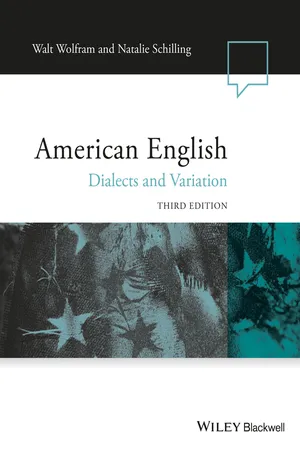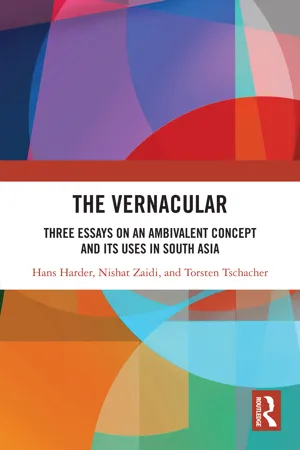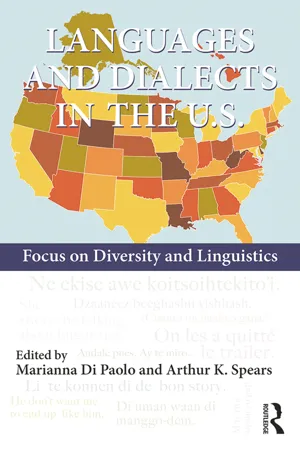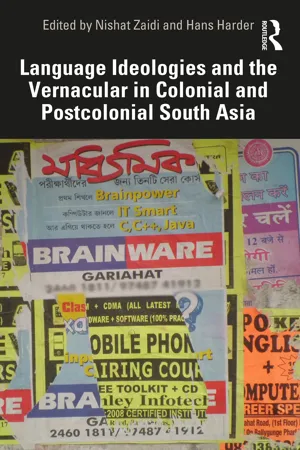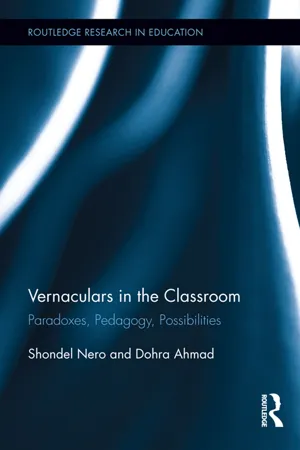Languages & Linguistics
Vernacular English
Vernacular English refers to the everyday spoken language used by a particular group of people in a specific region. It encompasses the informal, colloquial, and non-standard varieties of English, often characterized by unique vocabulary, grammar, and pronunciation. Vernacular English reflects the cultural and social identity of its speakers and is distinct from formal or standardized forms of the language.
Written by Perlego with AI-assistance
Related key terms
6 Key excerpts on "Vernacular English"
- eBook - ePub
American English
Dialects and Variation
- Walt Wolfram, Natalie Schilling(Authors)
- 2015(Publication Date)
- Wiley-Blackwell(Publisher)
She didn’t do nothing because “logic” dictates that two negatives equal a positive. In reality, though, language doesn’t work like math, and what we are really being taught is to avoid using language structures associated with the language varieties used by socially disfavored speakers. (In fact, in some other languages, for example Spanish, French, and Italian, double negatives are perfectly acceptable, indeed the only way to form negative sentences “correctly.”). When the dialects of socially disfavored groups become subordinated to the language forms preferred by the “right” people, non-mainstream dialects are trivialized or marginalized, and their speakers considered quaintly odd at best and willfully ignorant at worst. Furthermore, linguistic subordination comes with explicit promises and threats; opportunities will arise when we use a “standard” variety and doors will close when we speak a socially disfavored one. According to this principle, the speech of a socially subordinate group will be interpreted as linguistically inadequate by comparison with that of the socially dominant group.Linguists, who study the intricate patterning of language apart from its social evaluation, stand united against any definition of dialect as a corrupt version of the standard variety. A resolution adopted unanimously by the Linguistic Society of America at its annual meeting in 1997 asserted that “all human language systems – spoken, signed, and written – are fundamentally regular” and that characterizations of socially disfavored varieties as “slang, mutant, defective, ungrammatical, or broken English are incorrect and demeaning.”When the term “dialect” is used to refer to a kind of corrupt or unworthy English, it obviously carries very strong negative connotations. A clause such as “but it’s a very colorful way of speaking,” as in Quote 2 above, may soften the negative associations, but such statements must be made explicit to mitigate the commonly held assumption that some dialects aren’t as good as others. Typically, the popular use of the term “dialect” carries connotations ranging from mildly to strongly negative.Finally, the term “dialect” may be used popularly to refer to a specific, socially disfavored variety of English. A person speaking a recognized, socially stigmatized variety of English may be said to speak “the dialect” (“The kids … speak the dialect”). Such designations have, for example, been used to refer to the speech of low-income African Americans or rural Appalachians as a kind of euphemistic label for the varieties spoken by these groups. With the inclusion of the definite article, “the dialect” functions more like a proper noun than in the generic, neutral sense in which the term is used by linguistic scientists. - eBook - ePub
The Vernacular
Three Essays on an Ambivalent Concept and its Uses in South Asia
- Hans Harder, Nishat Zaidi, Torsten Tschacher(Authors)
- 2023(Publication Date)
- Routledge India(Publisher)
If employed without further explanations in Anglophone contexts on the Indian subcontinent, the term is readily understood today as referring to the non-English, spoken languages of South Asia. In this broadest sense, the vernacular or vernaculars in the plural thus have the potential to tie together a huge and very uneven array of hundreds of languages of different origins, statuses, ages, and sizes. As an umbrella term, vernacular is even more comprehensive than the denomination ‘regional languages’ for an overlapping category, since vernacular is open-ended and ready to capture the largest linguistic formations, such as Hindu-Urdu, together with the tiniest isolated varieties with very few speakers, such as certain ‘tribal languages.’ Vernacular in this sense readily comprises varieties of different linguistic stock, such as New Indo-Aryan, Dravidian, Austro-Asiatic, Iranian, Sino-Tibetan languages; it also brings together languages of great formal status and longstanding literary dominance – national and state languages – with unscripted and often endangered languages fighting for official recognition. But this great potential of vernacular of encompassing things very differently placed on the scales of prestige is not what we usually foreground when we use it. More often than not, in South Asia, vernacular serves merely to distinguish certain linguistic contexts (literary or filmic productions in whatever language at hand) from English ones. By extension, vernacular in South Asia also commonly refers to social settings, cultural spheres, and, particularly, architectonical traditions of local or regional origins – again in contradistinction to spheres or traditions connected with the colonial power or the globalised English-speaking world.However, this generalising use of vernacular as the collective, all-comprising Other of English on the Indian subcontinent, and thus as a comparatively powerless ensemble, has not remained uncontested. Sheldon Pollock’s model of vernacularisation does not apply to all the linguistic varieties mentioned above, and of course not in contradistinction to English, but to Sanskrit and other classical languages, and only to those that came to articulate regional authority or dominance (Pollock 2006 ). Partly along these lines, Ritipuspa Mishra has recently pointed out that the perception of powerlessness conceals the power with which certain vernaculars were invested by colonial policies and which they continue to command by the formation of linguistic states in postcolonial India (Mishra 2020 - eBook - ePub
Languages and Dialects in the U.S.
Focus on Diversity and Linguistics
- Marianna Di Paolo, Arthur K. Spears(Authors)
- 2014(Publication Date)
- Routledge(Publisher)
Part IIIEnglish and Other U.S. Language VarietiesPassage contains an image
6Vernacular Dialects of EnglishWalt WolframThe General Scope of Vernacular Dialects
The following exercises focus on vernacular (nonstandard) dialects of English on several levels. (See the introductory chapters and the chapter on African American English for definitions of the terms dialect and vernacular. ) First, they involve exercises that rely on “language intuitions.” By language intuitions , I mean the inner knowledge about language that comes from the fact that speakers of a language have internalized language patterns and therefore can make choices based on that knowledge. This knowledge stands apart from the ability to talk about language in technical terms. Everyone who speaks a language has language intuitions, whereas only linguistically trained professionals typically would have the knowledge to discuss these patterns in technical detail. Second, the exercises examine how judgments of linguistic well-formedness, or “grammaticality,” intersect with judgments of social acceptability. For many laypeople, linguistic grammaticality and social acceptability are not distinguished, but it is essential that this distinction be recognized in studying language, particularly in the study of language varieties that have been socially stigmatized.GrammaticalityGrammaticality refers to the conformity of a sentence or structure to the rules of the specific patterns of a language variety. For example, a sentence like The blue box is in the closet follows the rules for forming a sentence in English, whereas The box blue is in the closet is ungrammatical since it does not follow these general rules. This notion applies regardless of the social evaluation of a structure.Third, patterns are considered based on data sets that have been set up to illustrate the systematic distribution of forms in vernacular dialect grammar. The features included in these exercises range from those that are common to practically all the vernacular language varieties of American English—spoken by the majority of the population—to those figuring in the vernaculars of just a few hundred speakers. Both regional and sociocultural varieties in various combinations are included. For each exercise, the relevant vernacular dialect is given in the introduction to the exercise. - Nishat Zaidi, Hans Harder(Authors)
- 2023(Publication Date)
- Routledge India(Publisher)
Why not leave it at multilingualism? Why have ‘vernacular’ in the title? Multilingualism of course also covers up a host of hierarchical relationships, contact scenarios and historical and ongoing entanglements. But the ‘vernacular’ as it is commonly used today has the sharpest edge to it, provoking us to vector hierarchy into our considerations right from the start. The shortest way to evoke the relation between South Asian languages and English is to resort to this ambivalent, or some would say contentious category straight away. The ‘vernacular’ as a category commands a whole range of ambivalent meanings and has been a contested term ever since the colonial age. It is overshadowed by its etymology and colonial history and causes unease, prompting many authors to add disclaimers and apologies when using it, or using inverted commas – a practice we also heed in this introduction. But while implying a hierarchical setup and the subjugation of ‘lower’ languages under the ‘high variety’ of English with its cosmopolitan positioning, the ‘vernacular’ has also received empowering impulses and has been invested with qualities like groundedness and expressive strength. Thus, in the thoroughly multilingual literary and public spheres of South Asia, and in the context of the ongoing rise of literary Anglophonia in South Asia and particularly in post-liberalization India, a re-examination of the notion of ‘vernacularity’ in terms of competing language ideologies seems relevant.Today the term ‘vernacular’, hosted by the English language, is the only one that has the potential, at least in some of its uses, to divide up the complex linguistic landscape of South Asia into an English realm on the one hand and a large plurality of languages of the subcontinent on the other – unlike ‘South Asian languages’, which would immediately provoke questions about whether English shouldn’t be included, unless, as in our first sub-heading, both figure in an additive construction; also unlike bhāṣās, which would preferably be used for non-Sanskrit literary languages; and even unlike ‘regional languages’, which would again convey the larger languages with some official status.The term ‘vernacular’ has quite a complex history. Derived from Latin verna, domestic slave, it came to be employed to Latin itself as the language of the house as opposed to superposed Greek in Ancient Rome already, shedding its connotations with slavery to a large extent (Pollock 2006 : 22). In the Renaissance, it was the adjective vernaculum in its language-related sense, not the noun verna, that was borrowed by various emerging European languages. Its meaning shifted and now encompassed the regional, or non-classical languages of Europe in contrast to Latin (and Greek and Hebrew). This was how it was mainly (and infrequently) used in English until, in colonial South Asia, it underwent another shift in administrative use, now denoting the native South Asian languages in contradistinction to English itself.1- eBook - ePub
European Vernacular Literacy
A Sociolinguistic and Historical Introduction
- Joshua A. Fishman(Author)
- 2010(Publication Date)
- Multilingual Matters(Publisher)
Chapter 2 What is a ‘Language’ of Vernacular Literacy?Many crucial terms used in the social sciences are also used in everyday speech. The only problem is that in everyday usage terms are rarely precisely defined in advance. As a result, many a conversation that has gone on for hours may grind to a halt because one participant or another exclaims ‘But that is not what I mean when I say “freedom” (or “democracy”, or “peace”, or whatever)!’ In order for us not to be faced by any such problem after many pages, or even chapters, of our discussion, let us start by immediately defining the terms ‘language’. Does ‘slang’ qualify to be called a language? Does ‘Southern English’, like the kind that is spoken informally by many native residents of rural Mississippi, qualify? Does the native speech of recent Japanese immigrants from Okinawa, or that of newcomers to the US mainland from the coffee plantations near the southern coast of Puerto Rico or does the Spanish from ‘South of the border, down Mexico way’, qualify, because ‘almost everyone’s parents were native-speakers of either Spanish or one or another Amerindian language, all of which arrived here even before English did’? Does a spoken variety qualify even if it has no written counterpart at all, or even if it has no writing system? It would be good to get some of these questions clarified from the very beginning (not that full agreement may necessarily be reached even after ample discussion), so that we can all at least know if we are ‘on the same page’, even if we are not all on the same line of that page.A Dictionary Definition
A commonly used unabridged dictionary suggests a typical beginning definition of language as: ‘the way human beings communicate using words, whether written or spoken. It is also used for the particular system of communication used by a specific country, nation or community’ (Encarta, 1999: 1013). This particular dictionary then goes on to explain that ‘language’ is not the only way that individuals communicate and that it includes such subsidiary varieties as idiolects, dialects, slang, jargon, parlance, lingo, etc. The above overall definition could easily be ‘filled out’ by mentioning various further varieties of language, for example, occupational varieties, levels of formality in language, levels of seriousness in language, use of metaphor in language, related and unrelated languages, child language, animal languages, disturbed language, international and classical languages and so on. Gradually, what we originally took to be a simple, popular term, with a common meaning easily available to one and all, manifests itself to be full of unexpected complexities related to its widely differentiated users and uses. Obviously, only a modicum of reflection has revealed that there is nothing at all inherently simple about words such as ‘language’ and ‘languages’, since they reflect and convey all of the motivational and behavioral differences of the species that employ them, both to reveal and to disguise their goals, values and characteristics. - eBook - ePub
Vernaculars in the Classroom
Paradoxes, Pedagogy, Possibilities
- Shondel Nero, Dohra Ahmad(Authors)
- 2014(Publication Date)
- Routledge(Publisher)
For one thing, there are several varieties of English within so-called native speaking countries, all of which are not given equal validity in the native-speaking hierarchy, as we discussed earlier. For example, in the U.S., we find standardized American English as well as vernacular varieties like AAVE, HCE, Southern English, etc., that are given differential treatment in school. Beyond the U.S., the Anglophone Caribbean 1 was not included in the original concentric circles; it was considered a “special case” (Kachru, 1992). Why? Presumably because the region, with its integrated use of Caribbean Englishes and English-lexified Creoles, did not fit neatly into the “inner, outer, or expanding circles” of English nor to the ENL/ESL/EFL paradigm. Many Anglophone Caribbean residents include a mixture of Creole and English use in their self-identification as native speakers of English, and do not consider English as a second language. They are therefore surprised when their nativeness to English is called into question in an inner-circle country, as was the case with one of our students in a college class in New York City (Nero, 2001). In India, many speakers of Indian English might consider that variety their mother tongue and not see English as a second language in the traditional sense. In China today, because of the large number of English users, it is debatable whether English is a second or foreign language. Furthermore, identifying a native speaker of English or distinguishing between a native and non-native speaker or a native and nativized speaker is often more a question of social judgment or prejudice than linguistic proficiency (Kirkpatrick, 2007). A random group of people would be hard pressed to come to an agreement as to what a native speaker of English today actually looks like or sounds like
Index pages curate the most relevant extracts from our library of academic textbooks. They’ve been created using an in-house natural language model (NLM), each adding context and meaning to key research topics.
